Cool Science Experiments Headquarters
Making Science Fun, Easy to Teach and Exciting to Learn!
Science Experiments

Glowing Water Science Experiment
Do you have any predictions? With three bottles of water, one bottle filled with water mixed with highlighter dye, one bottle filled with tonic water, and one bottle filled with regular tap water, which ones do you think will glow?
Borrow a black light, get your supplies together, and give this simple and fun science experiment a try! We have a supplies list, printable instructions as well as a demonstration video with experiment explanation below. Explore phosphors and have fun while learning!
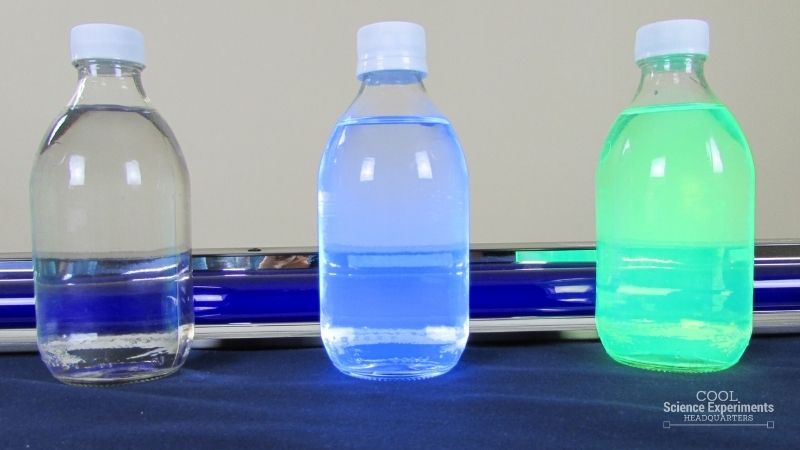
JUMP TO SECTION: Instructions | Video Tutorial | How it Works | Purchase Lab Kit
Supplies Needed
- 3 Empty Bottles or Drinking Glasses
- Highlighter
- Tonic Water
- Black light
Glowing Water Science Lab Kit – Only $5
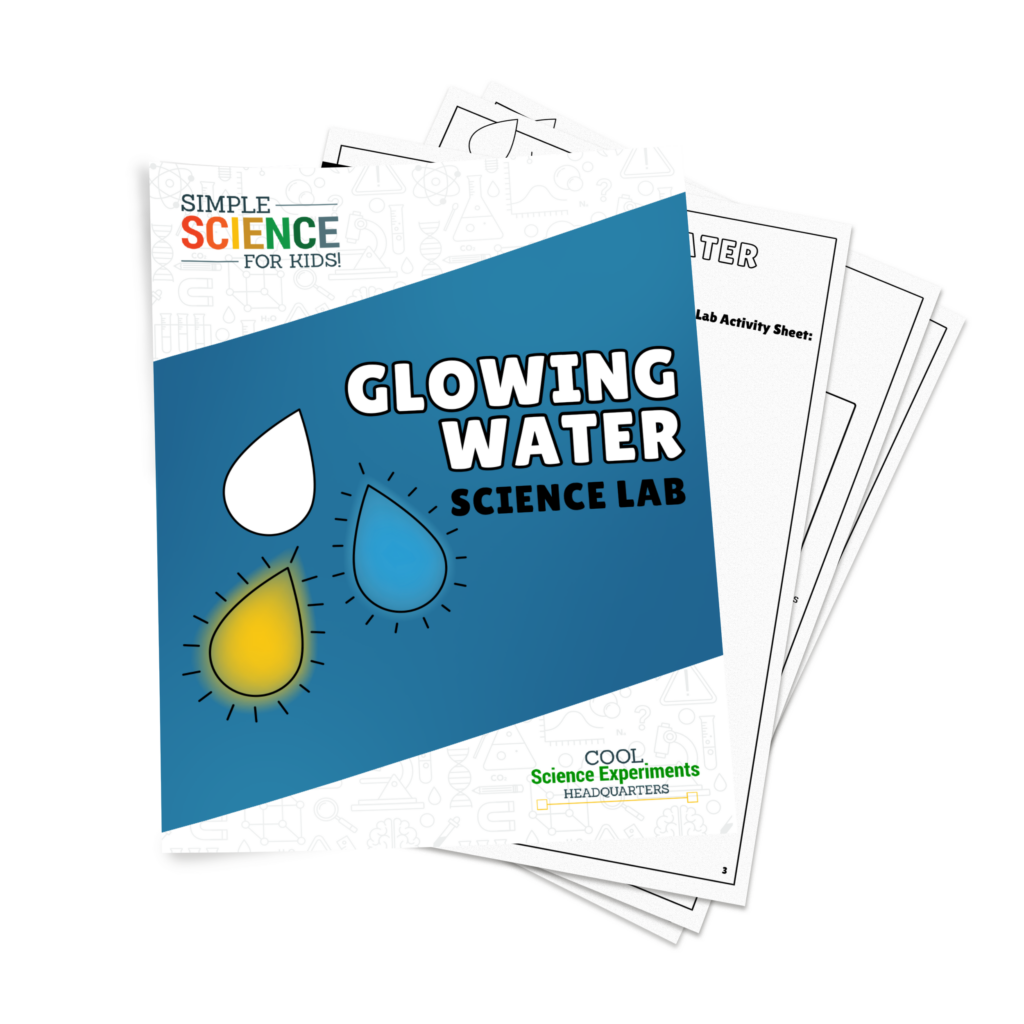
Use our easy Glowing Water Science Lab Kit to grab your students’ attention without the stress of planning!
It’s everything you need to make science easy for teachers and fun for students — using inexpensive materials you probably already have in your storage closet!
Glowing Water Science Experiment Instructions
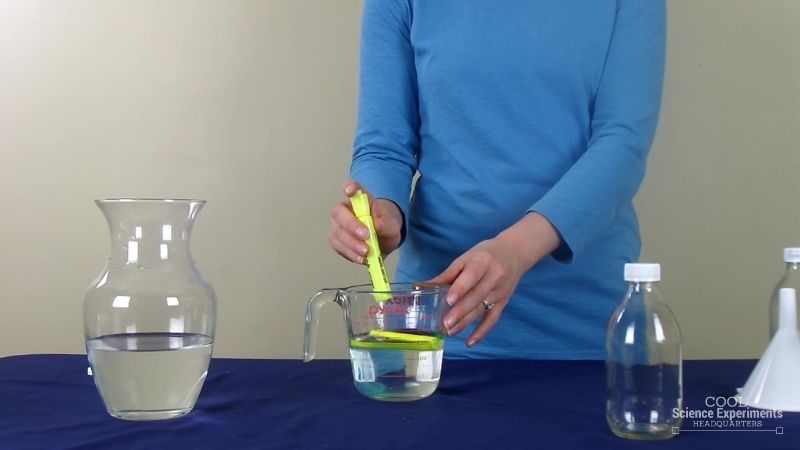
Step 1 – Prepare the water for the first bottle. To do so, pull the back off a highlighter and drop the ink into a cup of water. Set aside.
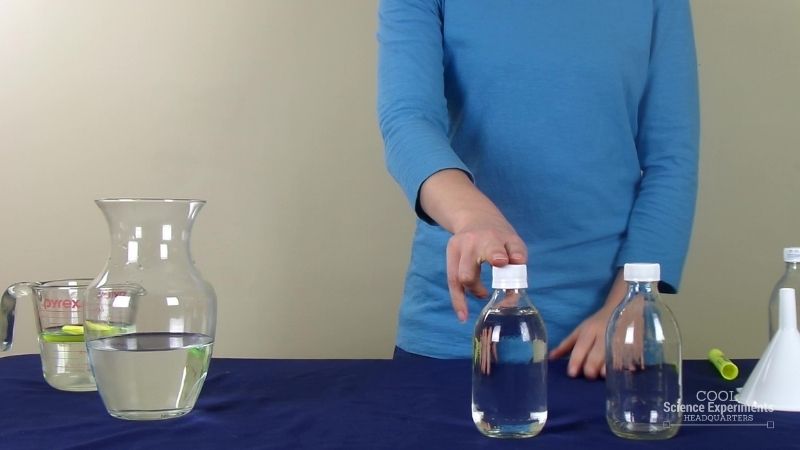
Step 2 – Prepare the water for the second bottle. Do this by filling the second bottle with tonic water.
Helpful Tip: If you buy tonic water that is already is a clear glass jar, you can just use that.
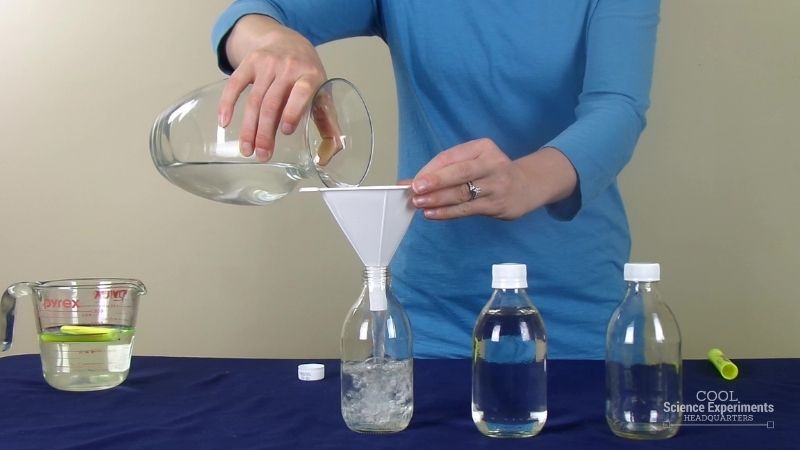
Step 3 – Prepare the water for the third bottle. Do this by filling the third bottle with regular tap water.
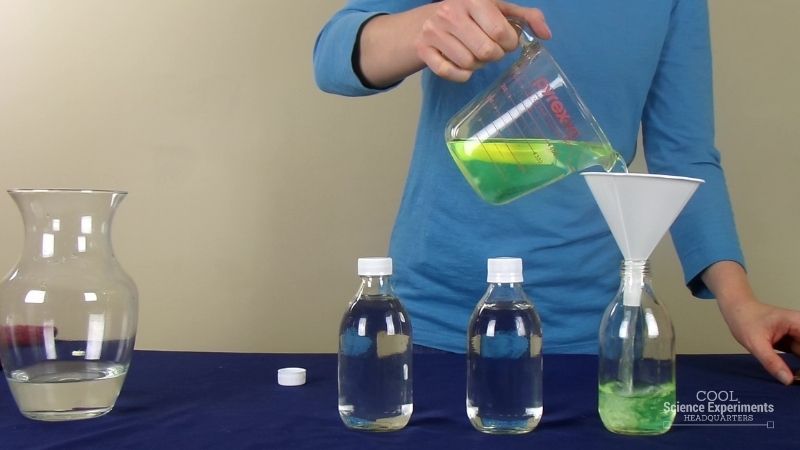
Step 4 – Take the water with the highlighter ink in it that you prepared in step one. Sir the water to mix in the ink and then pour it into the first bottle.
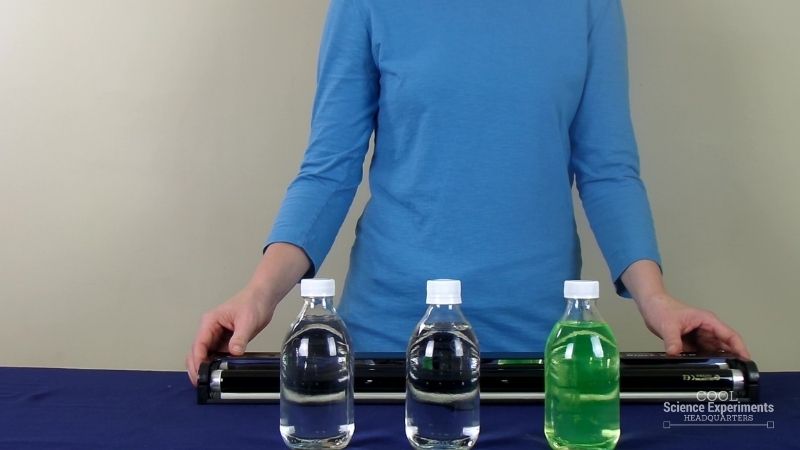
Step 5 – Position the black light behind the bottles.

Step 6 – Turn on the black light and observe the three bottles. Do any of them glow? Do you know why? Find out the answer in the how does this experiment work section below.
Video Tutorial
How Does the Science Experiment Work
The bottle with regular tap water does not glow when placed near a black light.
The bottle with water and highlighter dye and the bottle with tonic water do glow when placed near a black light. This is because highlighter dye and a chemical found in tonic water called quinine contain something called phosphors. Phosphors are substances that emit light (or luminesce) when exposed to radiation like UV light. When you shine a UV light on phosphors, the phosphors become “excited” and glow. Your teeth and fingernails also contain phosphors so they will also glow in UV light!
I hope you enjoyed the experiment. Here are some printable instructions:
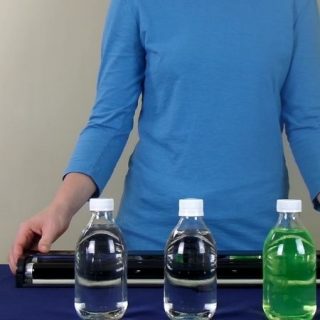
Instructions
- Prepare the water for the first bottle. To do so, pull the back off a highlighter and drop the ink into a cup of water. Set aside
- Prepare the water for the second bottle. Do this by filling the second bottle with tonic water. Tip: If you buy tonic water that is already is a clear glass jar, you can just use that.
- Prepare the water for the third bottle. Do this by filling the third bottle with regular tap water.
- Take the water with the highlighter ink in it that you prepared in step one. Sir the water to mix in the ink and then pour it into the first bottle.
- Position the black light behind the bottles.
- Turn on the black light and observe the three bottles. Do any of them glow? Do you know why?
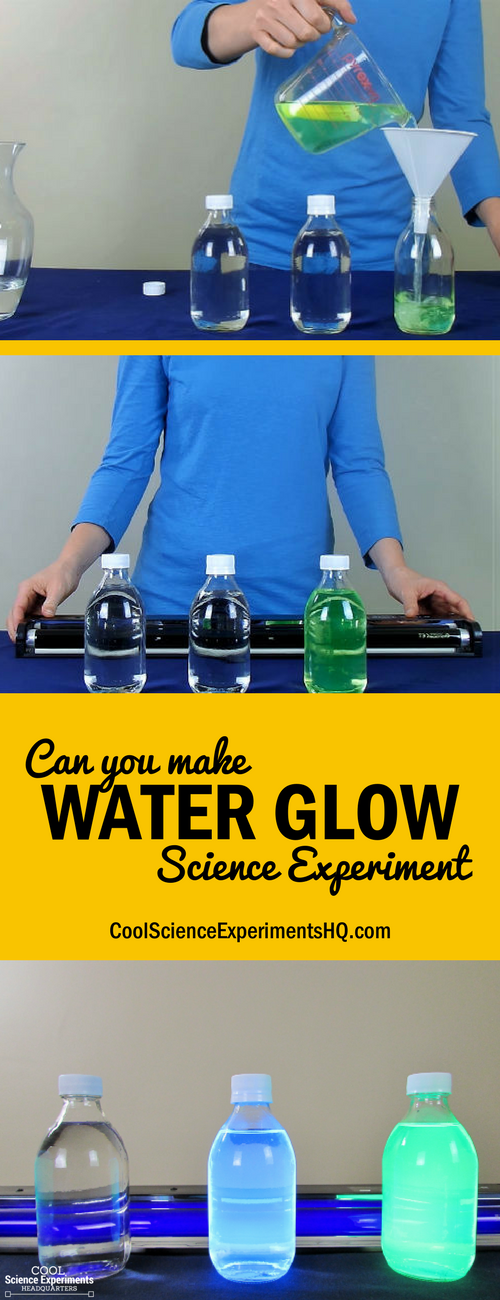
Reader Interactions
April 7, 2017 at 1:21 pm
where do you get tonic water besides online
October 18, 2017 at 8:54 pm
At the store
October 22, 2017 at 9:43 pm
A liquor store
January 31, 2018 at 10:32 pm
HEB or any grocery store near beer/ liquor isle.
April 9, 2018 at 5:45 pm
In wallmart
January 9, 2020 at 6:29 pm
I all was get my tonic water at wallmart.
January 19, 2019 at 11:53 am
Where do you get a black light and tonic water instead online? I love how you did it! Next year, for my science project I will do it.
January 23, 2020 at 9:31 pm
Both at Walmart
May 30, 2019 at 6:13 pm
My daughter did this experiment at school, yesterday. It was a big hit. I’d add the pic the teacher sent, if I knew how.
January 9, 2020 at 6:34 pm
Where do you get a black light and tonic water instead online?I love how you did it!Next year,for my science project I will do it.
March 12, 2020 at 5:01 pm
cool experiment
February 22, 2022 at 11:39 am
My friend and I are doing this experiment for our science fair project we just found it online. We cannot wait to do it!!! This is the first time we ever choose this!!!!
February 6, 2024 at 1:28 pm
I like this and I will do it for my 4th grade science project instead of forming neurons for a robot.
Leave a Reply Cancel reply
Your email address will not be published. Required fields are marked *
Save my name, email, and website in this browser for the next time I comment.

- Privacy Policy
- Disclosure Policy
Copyright © 2024 · Cool Science Experiments HQ
- Science, Tech, Math ›
- Chemistry ›
- Projects & Experiments ›
How to Make Glowing Water
Charles O'Rear/ Corbis Documentary / Getty Images
- Projects & Experiments
- Chemical Laws
- Periodic Table
- Scientific Method
- Biochemistry
- Physical Chemistry
- Medical Chemistry
- Chemistry In Everyday Life
- Famous Chemists
- Activities for Kids
- Abbreviations & Acronyms
- Weather & Climate
- Ph.D., Biomedical Sciences, University of Tennessee at Knoxville
- B.A., Physics and Mathematics, Hastings College
It's easy to make glowing water to use for fountains or as the basis for other projects. Basically, all you need is water and a chemical to make it glow. Here's what you need to do.
Chemicals That Make Water Glow in the Dark
There are a couple of ways you get science projects to glow in the dark . You can use glow-in-the-dark paint, which is phosphorescent and glows anywhere from a few minutes to a few hours. Glowing paint or powder tends not to be very soluble, so it is good for some projects and not others.
Tonic water glows very brightly when exposed to black light and is great for edible projects.
The fluorescent dye is another option for a bright effect under a black light. You can extract non-toxic fluorescent dye from a highlighter pen to make glowing water:
- Use a knife to (carefully) cut a highlighter pen in half. It's a pretty simple steak knife and cutting board procedure.
- Pull out the ink-soaked felt that is inside the pen.
- Soak the felt in a small quantity of water.
Once you have the dye you can add it to more water to make glowing fountains, grow certain types of glowing crystals, make glowing bubbles , and use it for many other water-based projects.
- Take Your Volcano Science Project to the Next Level
- 15 Fun Glow in the Dark Black Light Projects
- Crystal Projects Photo Gallery
- Fun Bubble Science Projects
- Special Effects Science
- How to Make Non-toxic Dry Ice Smoke or Fog
- How to Make Glow in the Dark Nail Polish
- Top Halloween Chemistry Projects
- Cool Halloween Jack o Lanterns
- 9th Grade Science Fair Projects
- Fake Neon Sign Tutorial (Fluorescence)
- Make Holiday Ornaments Using Chemistry
- Glowing Bubbles
- Make a Spinning Steel Wool Sparkler
- Middle School Science Fair Project Ideas
- Glow in the Dark Pumpkin Instructions

How to Make Glowing Water : Science Experiment
- December 13, 2020
- 10 Minute Science , 3-4 Year Olds , 5-6 Year Olds , Chemistry , Glow Science
In this article, lets discuss about ‘Glowing Water Science Experiment’.
Wondering how the things glow in the dark! Believe me, it can be a so much fun and at the same time kids learn something about the light science.
The main ingredient behind the glowing water is tonic water containing quinine compound.
Yes, tonic water does not look any strange when you see under normal light. But it does magic under black light. Let us learn the magic of tonic water further.
In this experiment, we are going to prepare and observe or analyse four different types of water filled in glass jars.
One glass jar is filled with normal tap water, one jar filled with tonic water, one jar filled with fluorescent pain, and the final jar is filled with the highlighter ink. Let’s find out which type of water glows.
I asked my kids to tell if they have any predictions.
My younger kid said all the four glass jar glow in the dark. Loll! No surprise for me to expect such funny answers from her.
But with the knowledge of previous glowing science experiment , my elder daughter gave me the answer i.e. ‘tonic water’. Now it’s time to appreciate my elder daughter. Hahaha! Reflects Mumma’s love!
Glowing Water Science Experiment
Supplies Needed
- 4 empty bottles or glasses or glass jars
- A black light (you can find them on online stores like Amazon and local hardware stores) or you can use a black light bulb
- A dark room to do the experiment
- Tonic water
- Highlighter pen
- Fluorescent paint
- Normal tap water
*Product Links are affiliate links – Your support is highly appreciated
Preparations

As we are using a highlighter ink, we need to extract highlighter ink from the highlighter pen. Open the highlighter pen by prying off the very top piece of the pen or by screwing the pen.
Take required amount of water in a glass beaker and then soak the felt inside the water. Keep in mind that lesser the water, the higher the concentration.
Follow the below mentioned steps to experience the magic does by our liquids under black light.

Step-1: Fill the glass 1 with normal tap water.
Step-2: Prepare another glass labelled 2 for the experiment. To do so, fill the glass with tonic water.
Step-3: Now take the third glass and fill with the normal water. Here we are using fluorescent paint to mix it with the water. Set aside.
Step-4: Then prepare the glass 4 for the experiment by filling water and with highlighter ink. We have already discussed how to make the highlighter ink in ‘preparations’ heading.
Now all the glasses are ready to glow in the dark room.
Time to Glow

My daughters helped me to place all the four glasses filled with different liquids in the dark room which we have set up for the experiment.
Now I asked my daughters to set the black light about 12 inches away from the liquids in the glasses.
And see the magic by the black light in the dark room.
My kids are amazed by the glow of the water with a small suspense in their faces. Here are the results you can see from the picture.
How does the glowing water science experiment works and the science behind it!!
As we see in the picture, glass 1 with normal tap water does not glow under black light.
Whereas glass 2 with tonic water glows amazingly under black light. The ultra violet rays being emitted by the black light makes the tonic water glow.
But how? Tonic water contains a chemical compound called quinine. Quinine under black light turns the invisible ultra violet rays to visible rays making the water glow in the dark.
That is the reason black lights are used in forensic labs, photography, artistic performances, antiques, authentication of bank notes etc.
The electromagnetic rays being emitted by the black light make the things that contain phosphors glow in the dark.
Phosphors are such compounds that gets excited and emit light under radiation. This phenomenon is called luminescence.
The chemical compound quinine in tonic water contains phosphors which is why the tonic water glows under black light.

Coming to the experiment glass filled with highlighter ink, we see a bright colored glow after it is exposed to black light.
The highlighter ink contains phosphors which gets reacted with the UV-A light spectrum coming from the black light. Thus making the water glow by emitting visible light.
Next moving on to the glass filled with water and fluorescent paint. The reason for the glowing water applies here.
The phosphors in the fluorescent paint makes the water glow under black light.

What is Black Light?
Let’s learn – What is Black Light? It sounds contradictory. Black light is a small light that emits light from the range of ultra violet-A light spectrum.
It is actually invisible to human eye and is purple in color.
Since the light emitted from the black light is outside the range of human vision, a room appears dark when illuminated with a black light. It causes every day or daily life objects glow in the dark.
Safety Measures
- The black light that we used made for domestic use and not necessarily can cause harm to kids. However, please be wary of using black light with kids. The light may cause irritation to sensitive skin.
- Do not let kids to drink/taste any of the liquids we are experimenting with.
- When handling the tonic water, please read the safety precautions listed on the container.
Hope you enjoyed the experiment!! Performing the experiment in the dark room is even more exciting for the kids and hope your kids also enjoy this experiment. Give it a try.
Leave a Reply Cancel Reply
Your email address will not be published. Required fields are marked *
Name *
Email *
Add Comment *
Save my name, email, and website in this browser for the next time I comment.
Post Comment

- Science Notes Posts
- Contact Science Notes
- Todd Helmenstine Biography
- Anne Helmenstine Biography
- Free Printable Periodic Tables (PDF and PNG)
- Periodic Table Wallpapers
- Interactive Periodic Table
- Periodic Table Posters
- Science Experiments for Kids
- How to Grow Crystals
- Chemistry Projects
- Fire and Flames Projects
- Holiday Science
- Chemistry Problems With Answers
- Physics Problems
- Unit Conversion Example Problems
- Chemistry Worksheets
- Biology Worksheets
- Periodic Table Worksheets
- Physical Science Worksheets
- Science Lab Worksheets
- My Amazon Books
How to Make Glowing Water

Glowing water is useful for making spectacular fountains, “magic” potions, and for added pizazz for a party or science project.
Chemicals to Make Water Glow in the Dark
Ordinarily, water doesn’t glow. There’s actually an exception to this. Water in a nuclear reactor does glow blue due to Cherenkov radiation . So, if you’ve got some spent nuclear fuel rods sitting around the house, the easiest way to make water glow is to toss one in.
Assuming that’s either impractical for you or else you fear radiation poisoning, you can use chemicals to make water fluoresce under black light or else phosphoresce (truly glow in the dark). Here are chemicals you can add and what to expect:
Tonic Water : If blue is your color, save yourself a lot of time and effort and simply use tonic water with a black (ultraviolet) light. Tonic water contains quinine, which glows bright bluel Tonic water is safe to drink. Mixing tonic water with bubble solution works great for blowing bubbles that glow under black light.
Vitamin B12 : Adding vitamin B12 adds a bright yellow glow under a black light. Vitamin B12 is usually sold in tablets that don’t dissolve well in water. To get the vitamin away from the powdery filler, dissolve the tablet in a small amount of vinegar. Run the mixture through a coffee filter to remove particulates and add the liquid to water. Vitamin B12 is safe to add to drinks.
Chlorophyl l: While chlorophyll is green, it glows a dull red under a black light. If you add it to water, it tends to sink to the bottom of a container, illuminating it from below. Chlorophyll is safe to put in drinks, but it may add a “green” flavor, depending on your source.
Highlighter Ink : If you want a rainbow of colors, add ink from highlighter pens to water and use a black light. First, check the highlighter ink under UV light, because not all of them are actually fluorescent. Yellow and green are pretty reliable. Orange and red are iffy. Blue and purple rarely glow under black light. To get the ink from the pen, carefully cut the pen open (I used a knife and a cutting board) and use pliers or tweezers to extract the ink pad from the pen innards. Soak the felt in a small amount of water. You can store this “glow ink” in a plastic bag for future use. Highlighter ink is non-toxic, but isn’t meant to be ingested and tastes awful. Use it as a decoration, but do not add it to food or drinks. It make beautiful glowing flowers !
Glow Powder : Make true glowing water by either adding phosphorescent glow powder to the water or placing it below a clear container holding the water. Some glow powder is deactivated by water, plus it doesn’t dissolve. Since the powder sinks, you’re better off illuminating the liquid from below by adding “glow” to its container. Remember to charge the powder with a strong light source (ideally the Sun or a black light) before turning out the lights. A good powder keeps glowing a full day.
As a side note, if you don’t like either nuclear or chemical methods of making water glow, you could add a bioluminescent organism to the water. Dinoflagellates produce glowing blue tides. You can buy these creatures online or visit the ocean to see them in their natural habitat.
Glowing Water Video Tutorial
If you’re unsure how to go about dissecting a highlighter, here’s my original video that shows how to do it and what to expect when you turn on a black light.
Related Posts

Scientifically Spooky Soda

This glowing water science experiment is both fun and easy to do. Kids will learn about the properties of UV light when using a blacklight to try to make various cups of water glow.
You also may be interested in:
- Kiwi Co Reviews
- Fizzy Melting Ghosts
- Cornstarch and Water Science Experiment
Supplies Needed
- Glowing Spooky Soda
- Tonic water
- UV Blacklight
- Bleach (optional)
- Clear plastic disposable cup
- Medicine D ropper
Glowing Water with Florescent Paint
- Neon colored water-soluble or tempera based fl u orescent paint . Lemon yellow and lime green glows the brightest.
- Glass of water in a disposable cup
- UV Blacklight
Glowing Water with Highlighters
- Neon Highlighters that glow. (Check to see if the highlighter glows by writing on white paper and shining a black light on it). The color influences the intensity of the glow. Yellow highlighters may possibly glow the brightest .
- Scissors, pliers, or knife
- A Glass of w ater in a disposable cup
Glowing Water with Glow Sticks
- Large glow sticks
- Scissors or knife
- Water in a disposable cup
- Water in the same disposable cup style as the others.
What Mystery Are We Solving?
Why does tonic water become spooky soda that glows in the dark when UV blacklight shines on it? Is it the same reason why waterlogged highlighters create glowing water or are the chemistry different?
Safety Issues
DO NOT DRINK the spooky glowing water. Some of the ingredients are toxic, for example , the glow sticks and tonic water with bleach .
Adult supervision is recommended to limit the mess caused by highlighter ink or paint. Broken glow sticks may have pieces of glass inside that could accidentally cut fingers. Bleach may burn if it comes into contact with skin and could bleach colored clothing.
How To/Directions
There are many ways to attack this expirment. To begin, fill your normal water cup and set it aside.
You can then choose whatever of the following “glowing” water sources you want – or all of them – to compare against normal tap water.
Glowing Water
- Turn the lights off and shine the black light on the bottle of tonic water.
- Pour some tonic water in a glass.
- Add a few drops of bleach and notice the difference when the ultraviolet light shines on it. The spooky water isn’t spooky anymore.
- Pour tonic water in another glass and dilute with water. Notice how the glowing effect decreases.
Glowing Water with Florescent Paint
- Fill glass three-quarters with warm water.
- Add the paint to the glass of water.
- Stir to dissolve the paint in the water.
- Immediately turn off the lights and shine the black light on the glow ing water. If you wait too long to perform this step, the paint will sink to the bottom of the glass spoiling the effect.
Glowing Water with Highlighters
- Pour a few inches of water in a glass.
- Use the pliers to remove the highlighter felt or cut it with a knife. Be careful the ink will drip.
- Immerse the felt in a glass of water. Be mindful that the more water the less the effect.
- Wait at least 10 minutes for the ink to be released into the water.
- Remove the felt.
- Stir the water to distribute the color.
- Turn the light off in the room so that the room is dark.
- Switch on the UV light and observe the neon glowing water.
Glowing Spooky Water with Glow Sticks
- Fill a glass with water.
- Bend the glow stick to break the glass tube inside.
- Cut off one end of the glow stick. Be careful of possible glass pieces.
- Place the plastic tube in a glass of water for a concentrated glowing effect at the bottom of the glass. Remove the capsule and pour the liquid in the glass of water for overall glowing water.
- Turn the lights off . You don’t need a black light to see the effect of the glowing spooky water.
What Just Happened Here?
Blacklight releases invisible UVA radiation ( ultraviolet radiation type A) that is harmless. The purple light you seen with a black UVA light , however, isn’t the invisible UVA radiation .
The chemical phosphor absorbs the invisible UVA radiation and releases a visible light which is seen as glowing in the dark. In the highlighters, paint and sticks the phosp horus is fluorescent which releases the light quickly and doesn’t last long.
The fluoresces effect in t onic water, however, isn’t because of phosphorus. Tonic water contains the chemical quinine that gives the tonic water the bitter taste. The quinine is excited by the blacklight and it absorbs the UVA radiation . When it returns to its normal unexcited state, it releases the visible blue glowing light .
The chemical bleach is an oxidising agent that prevents quinine from absorbing the UVA radiation. The oxidising agent breaks the chemical carbon-carbon double bonds and the spooky water stops glowing bright blue.
More Resources
https://visihow.com/Make_Glowing_Water
http://experimentexchange.com/physics_force-energy-motion/make-glowing-water/
https://sciencing.com/make-water-science-fair-project-8302785.html
https://www.scientificamerican.com/article/shining-science-explore-glow-in-the-dark-water/
https://www.thedailymeal.com/cook/reason-tonic-water-glows-dark

Retha Groenewald is a professional writer working for FractusLearning. When not working with Fractus, she is web copywriter for the Christian market. Her writing is featured at Christian Web Copywriter and at Writing That Breathes Life.
One Comment
Love this experiment, I hope you do not mind I include it in my round up on my blog. Thx
Leave a Reply Cancel reply
Your email address will not be published. Required fields are marked *
This site uses Akismet to reduce spam. Learn how your comment data is processed .

COMMENTS
Learn how to make water glow with highlighter dye, tonic water and a black light. Explore phosphors and have fun with this simple and easy science experiment.
In this science activity, you will make tonic water glow by using a black light, and then you will add a little bleach to the water. How will adding bleach affect the glow of the tonic water? ... This activity is not recommended for use as a science fair project. Good science fair projects have a stronger focus on controlling variables, taking ...
Learn how to create glowing water with simple chemicals, such as glow-in-the-dark paint, tonic water, or highlighter ink. Find out how to use glowing water for fountains, crystals, bubbles, and more.
Learn how to make glowing water using tonic water, fluorescent paint and highlighter pen. Discover the science behind the glow and the difference between black light and normal light.
Glowing water is useful for making spectacular fountains, "magic" potions, and for added pizazz for a party or science project. Chemicals to Make Water Glow in the Dark. Ordinarily, water doesn't glow. There's actually an exception to this. Water in a nuclear reactor does glow blue due to Cherenkov radiation. So, if you've got some ...
Sign up for Cool Science Experiments FREE Weekly Newsletter: http://coolscienceexperimentshq.com/subscribeTo find even more cool science experiments visit: h...
Learn about bioluminescence in nature by creating "glowing water." Learn more about "Lyla in the Loop," a new animated series full of fun, adventure, and creative problem-solving. ...
Glowing Spooky Water with Glow Sticks Fill a glass with water. Bend the glow stick to break the glass tube inside. Cut off one end of the glow stick. Be careful of possible glass pieces. Place the plastic tube in a glass of water for a concentrated glowing effect at the bottom of the glass. Remove the capsule and pour the liquid in the glass of ...
Make Glowing Water. Make glowing water with the help of a black light in this fun science experiment for kids. Tonic water doesn't look very strange under normal light but what happens when you look at it under a black light? Does the dye from a highlighter pen do the same thing? Find out what happens and why it happens with this cool ...
SUBSCRIBE: https://goo.gl/hzFT7I How to make glowing water! An easy and fun glow in the dark science experiment for kids! All you need is water, highlighter...